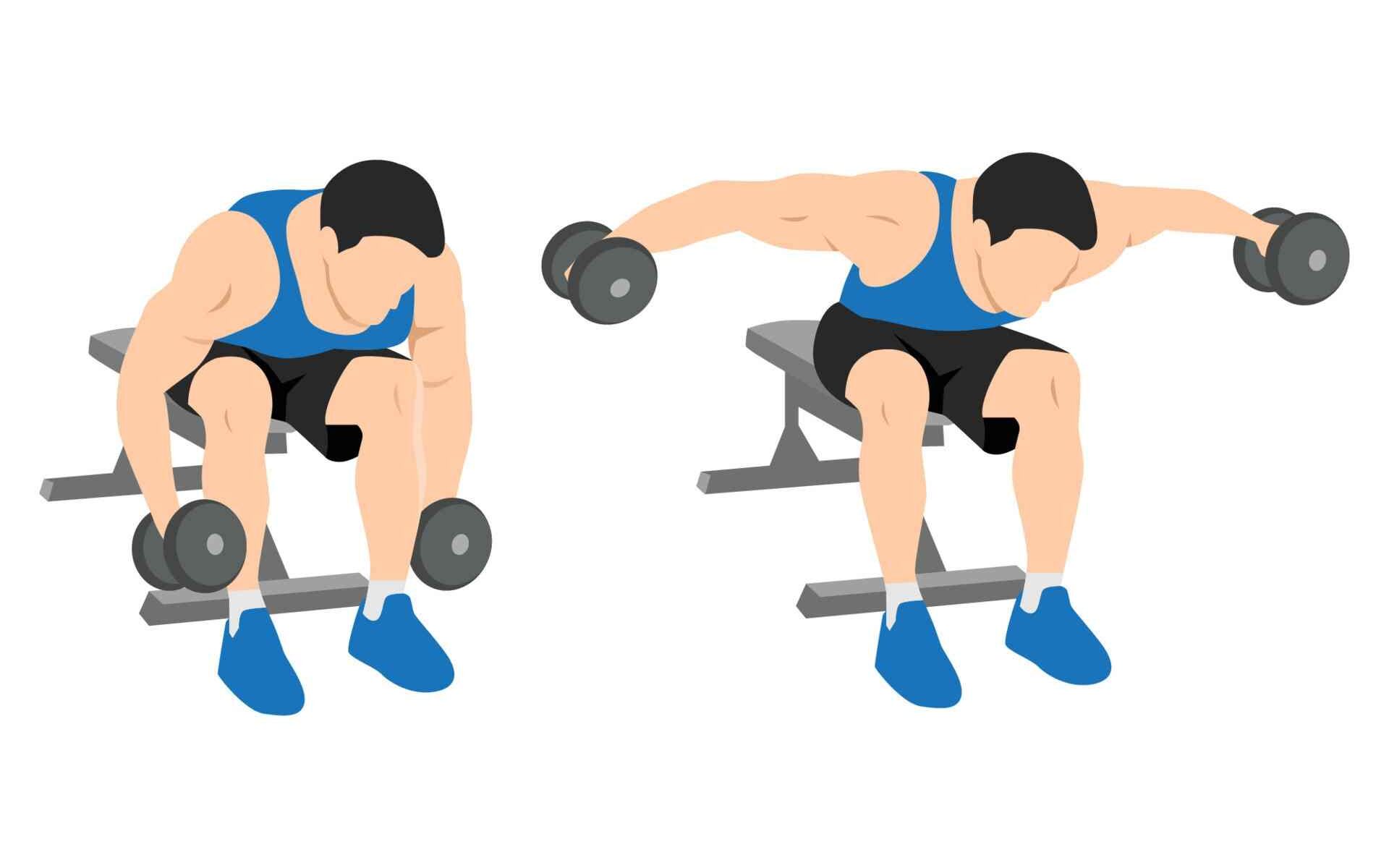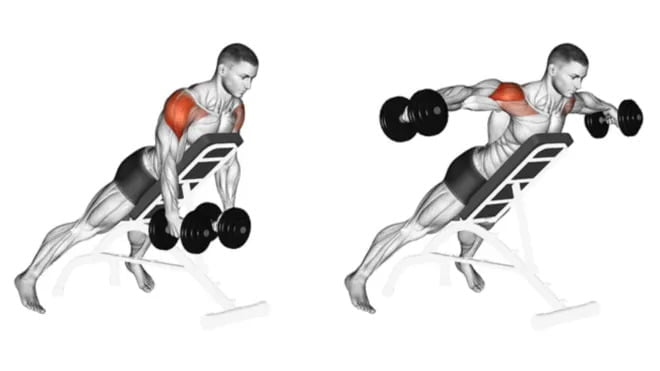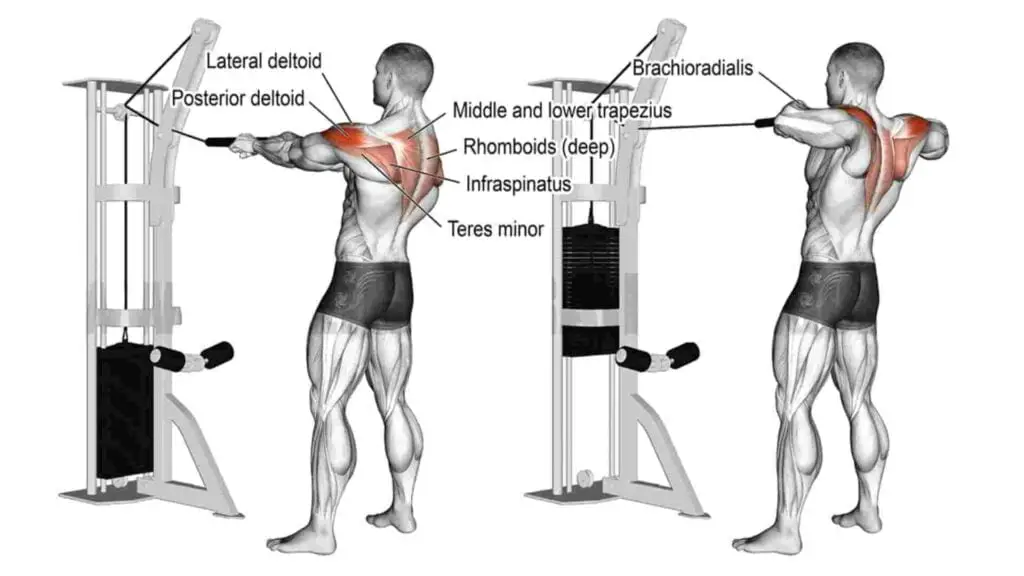Introduction
The rear deltoids, or rear delts for short, are a muscle group located on the back of the shoulders that are often overlooked in training. However, developing strong rear delts is important for overall shoulder health and aesthetics.
By targeting the rear delts with exercises, you can improve your posture, increase shoulder stability, and reduce the risk of injury. Additionally, strong rear delts can give your shoulders a more complete and balanced look, which is desirable for many people who are into bodybuilding or fitness.
Dumbbells are a versatile and convenient tool for training the rear delts. They allow you to perform a variety of exercises that can effectively target this muscle group from different angles and with varying degrees of resistance. Dumbbell exercises can also be performed at home or in the gym, making them accessible to a wide range of people with different fitness levels and goals.
So, if you’re looking to develop strong and aesthetically pleasing shoulders, incorporating rear delt exercises with dumbbells into your workout routine can be a smart choice.
Anatomy of the Rear Deltoids
The rear deltoids, also known as the posterior deltoids, are one of the three heads of the deltoid muscle group in the shoulder. They are located at the back of the shoulder, and their primary function is to assist with arm movement, particularly in movements that involve pulling the arm backward and away from the body.
The rear deltoids originate from the scapula (shoulder blade) and attach to the humerus (upper arm bone). When the rear deltoids contract, they pull the arm backward and away from the body, which is known as horizontal abduction. They also play a role in shoulder extension, which is when the arm moves backward behind the body.
Having well-developed rear deltoids is important for overall shoulder health and stability, as well as for improving posture and preventing shoulder injuries. Incorporating rear delt exercises with dumbbells into your workout routine can help to strengthen and develop these muscles, leading to improved shoulder function and aesthetics.
Rear Delt Exercises with Dumbbells
There are several exercises that you can do with dumbbells to target your rear deltoids (posterior deltoids), which are the muscles located at the back of your shoulders. Here are five effective exercises:
Rear Delt Fly

This exercise targets the rear delts, the small muscles at the back of your shoulders. It involves lifting dumbbells out to the sides while maintaining a slight bend in your elbows.
Technique:
- Hold a pair of dumbbells in each hand and stand with your feet shoulder-width apart.
- Bend your knees slightly and hinge at the hips to lean forward, keeping your back flat and core engaged.
- Keep your arms straight and lift the dumbbells out to the sides, squeezing your shoulder blades together.
- Lower the weights back down in a controlled manner.
Variations:
- To increase the difficulty, you can use heavier dumbbells or perform the exercise standing on one leg to challenge your balance.
- To decrease the difficulty, you can use lighter dumbbells or perform the exercise while seated.
Common mistakes and how to avoid them:
- Using momentum to lift the weights, rather than focusing on using your rear deltoids. To avoid this, use a controlled motion and focus on squeezing your shoulder blades together.
- Arching your back or shrugging your shoulders. Keep your back flat and shoulders down throughout the exercise.
Bent-Over Rear Delt Raise
This exercise involves lifting dumbbells out to the sides while bent over with a slight forward hinge, targeting the rear delts and upper back muscles.
Technique:
- Hold a pair of dumbbells in each hand and bend your knees slightly.
- Hinge at the hips to lean forward, keeping your back flat and core engaged.
- With your arms hanging straight down, lift the dumbbells out to the sides, squeezing your shoulder blades together.
- Lower the weights back down in a controlled manner.
Variations:
- To increase the difficulty, you can use heavier dumbbells or perform the exercise while standing on one leg to challenge your balance.
- To decrease the difficulty, you can use lighter dumbbells or perform the exercise while seated.
Common mistakes and how to avoid them:
- Using momentum to lift the weights, rather than focusing on using your rear deltoids. To avoid this, use a controlled motion and focus on squeezing your shoulder blades together.
- Rounding your back or looking down. Keep your back flat and gaze forward throughout the exercise.
Seated Rear Delt Raise

The Seated Rear Delt Raise is a dumbbell exercise that targets the rear delts. It involves sitting on a bench and lifting dumbbells out to the sides while keeping your elbows slightly bent.
Technique:
- Sit on a bench or chair with your back straight and feet flat on the ground.
- Hold a pair of dumbbells in each hand and let your arms hang straight down.
- Raise the dumbbells out to the sides, squeezing your shoulder blades together.
- Lower the weights back down in a controlled manner.
Variations:
- To increase the difficulty, you can use heavier dumbbells or perform the exercise while standing on one leg to challenge your balance.
- To decrease the difficulty, you can use lighter dumbbells or perform the exercise while standing against a wall for support.
Common mistakes and how to avoid them:
- Using momentum to lift the weights, rather than focusing on using your rear deltoids. To avoid this, use a controlled motion and focus on squeezing your shoulder blades together.
- Shrugging your shoulders or rounding your back. Keep your shoulders down and back straight throughout the exercise.
Incline Rear Delt Fly

This variation of the rear delt fly involves performing the exercise while lying face down on an incline bench, which increases the range of motion and the challenge to your rear delts.
Technique:
- Lie face down on an incline bench with a slight bend in your elbows and a dumbbell in each hand.
- Keeping your arms straight, raise the dumbbells out to the sides until they are level with your shoulders.
- Squeeze your shoulder blades together at the top of the movement.
- Lower the weights back down in a controlled manner.
Variations:
- To increase the difficulty, you can use heavier dumbbells or increase the incline of the bench.
- To decrease the difficulty, you can use lighter dumbbells or decrease the incline of the bench.
Common mistakes and how to avoid them:
- Raising the weights too high or using momentum to lift them. Keep your elbows slightly bent and focus on using your rear deltoids.
- Arching your back or shrugging your shoulders. Keep your back flat and shoulders down throughout the exercise.
Rear Delt Pull

This exercise involves pulling dumbbells back towards your ribcage while standing with a slight forward hinge. It primarily targets the rear delts but also works the upper back muscles.
Technique:
- Hold a dumbbell in each hand and stand with your feet hip-width apart.
- Hinge forward at the hips with a flat back and extend your arms down in front of you.
- Pull the dumbbells back towards your ribcage, keeping your elbows close to your sides and squeezing your shoulder blades together.
- Lower the weights back down in a controlled manner.
Variations:
- To increase the difficulty, you can use heavier dumbbells or perform the exercise standing on one leg to challenge your balance.
- To decrease the difficulty, you can use lighter dumbbells or perform the exercise while seated.
Common mistakes and how to avoid them:
- Using momentum to pull the weights, rather than using your rear deltoids. Keep your motion slow and controlled.
- Rounding your back or looking down. Keep your back flat and gaze forward throughout the exercise.
Prone Rear Delt Raise
This exercise involves lifting dumbbells out to the sides while lying face down on a bench, targeting the rear delts and upper back muscles.
Technique:
- Lie face down on a bench with a dumbbell in each hand, palms facing each other.
- Lift the dumbbells out to the sides, keeping your arms straight and squeezing your shoulder blades together.
- Lower the weights back down in a controlled manner.
Variations:
- To increase the difficulty, you can use heavier dumbbells or increase the range of motion by lifting the weights higher.
- To decrease the difficulty, you can use lighter dumbbells or decrease the range of motion by lifting the weights lower.
Common mistakes and how to avoid them:
- Using momentum to lift the weights, rather than focusing on using your rear deltoids. To avoid this, use a controlled motion and focus on squeezing your shoulder blades together.
- Rounding your back or looking down. Keep your back flat and gaze forward throughout the exercise.
Bent Over Rear Delt Fly
The Bent Over Rear Delt Fly is a popular exercise that targets the rear deltoids using dumbbells. It is an effective movement for building upper back strength and improving posture. Proper form and technique are essential to get the most out of this exercise.
Technique:
- Stand with your feet shoulder-width apart and hold a dumbbell in each hand.
- Hinge forward at the hips with a flat back and extend your arms down in front of you.
- Keeping your arms straight, lift the dumbbells out to the sides until they are level with your shoulders.
- Squeeze your shoulder blades together at the top of the movement.
- Lower the weights back down in a controlled manner.
Variations:
- To increase the difficulty, you can use heavier dumbbells or perform the exercise with a pause at the top of the movement.
- To decrease the difficulty, you can use lighter dumbbells or perform the exercise while seated.
Common mistakes and how to avoid them:
- Using momentum to lift the weights, rather than focusing on using your rear deltoids. Keep the motion slow and controlled.
- Rounding your back or looking down. Keep your back flat and gaze forward throughout the exercise.
Sample Rear Delt Workout with Dumbbells
Here’s a sample rear delt workout with dumbbells that you can use to develop your rear deltoids:
Exercise 1: Rear Delt Fly
- Perform 3 sets of 12-15 reps with a moderate weight
- Rest for 60 seconds between sets
- Technique: Stand with your feet shoulder-width apart, holding a pair of dumbbells in front of your thighs with your palms facing each other. Hinge forward at the hips, keeping your back straight and your knees slightly bent. Raise the dumbbells out to the sides until your arms are parallel to the ground, squeezing your shoulder blades together at the top. Lower the weights back down with control and repeat.
Exercise 2: Bent-Over Rear Delt Raise
- Perform 3 sets of 12-15 reps with a moderate weight
- Rest for 60 seconds between sets
- Technique: Stand with your feet shoulder-width apart, holding a pair of dumbbells with an overhand grip in front of your thighs. Hinge forward at the hips, keeping your back straight and your knees slightly bent. Raise the dumbbells out to the sides until your arms are parallel to the ground, squeezing your shoulder blades together at the top. Lower the weights back down with control and repeat.
Exercise 3: Seated Rear Delt Raise
- Perform 3 sets of 12-15 reps with a lightweight
- Rest for 60 seconds between sets
- Technique: Sit on the edge of a bench with your feet flat on the floor and your back straight. Hold a pair of dumbbells with an overhand grip and let them hang down at arm’s length by your sides. Raise the dumbbells out to the sides until your arms are parallel to the ground, squeezing your shoulder blades together at the top. Lower the weights back down with control and repeat.
When structuring a rear delt workout with dumbbells, it’s important to include exercises that target the rear deltoids from different angles. This will help to fully develop the muscle group and prevent imbalances. In the sample workout above, we included a standing exercise (rear delt fly), a bent-over exercise (bent-over rear delt raise), and a seated exercise (seated rear delt raise) to target the rear deltoids from different angles.
To maximize your results, you can perform this workout once or twice per week, depending on your fitness level and recovery ability. Make sure to use proper form, choose an appropriate weight for your fitness level, and progressively increase the weight or reps over time to challenge your muscles and continue making progress.
To ensure safe and effective training, it’s also important to warm up properly before your workout and stretch afterward. You can also consult with a certified personal trainer if you’re new to working out or have any specific concerns or injuries.
How to Progress in Rear Delt Exercises with Dumbbells
When it comes to progressing in rear delt exercises with dumbbells, there are several strategies you can use to challenge yourself and keep making progress. Here are three effective ways to progress:
- Increasing Weight: One of the simplest ways to progress in rear delt exercises with dumbbells is to gradually increase the weight you’re using. As you become stronger and more comfortable with the exercise, you can start using heavier weights to challenge your muscles even more. However, it’s important to be careful not to increase the weight too quickly or use a weight that’s too heavy, as this can lead to injury or compromise your form.
- Changing the Angle of the Exercise: Another way to progress in rear delt exercises with dumbbells is to change the angle of the exercise. For example, you can do rear delt flys while lying face down on an incline bench, or you can do bent-over rear delt raises with your torso at a steeper angle. Changing the angle of the exercise can challenge your rear deltoids in different ways and prevent your muscles from getting too used to the same movement pattern.
- Incorporating Supersets and Drop Sets: Finally, you can incorporate supersets and drop sets into your rear delt workouts to add intensity and challenge your muscles even further. For example, you could do a set of rear delt flys with dumbbells, followed immediately by a set of bent-over rear delt raises with the same weight. Alternatively, you could do a set of rear delt flys with progressively lighter weights, decreasing the weight each time until you reach failure. These techniques can be effective for increasing muscle hypertrophy and improving overall strength.
Remember, it’s important to progress gradually and safely in your rear delt exercises with dumbbells. Listen to your body and don’t push yourself too hard too quickly, as this can lead to injury or burnout. By incorporating these strategies into your training routine, you can continue making progress and building strong, defined rear deltoids.
FAQs
Q. How often should I train my rear delts with dumbbells?
Ans. It depends on your goals and training program. Generally, it’s recommended to train your rear delts 1-2 times per week, alongside other shoulder exercises. However, if you’re looking to specifically target your rear delts or have lagging rear delt development, you may want to train them more frequently.
Q. Can I do these exercises with a resistance band instead of dumbbells?
Ans. Yes! Rear delt exercises can be done with resistance bands, which can be a great alternative to dumbbells if you don’t have access to weights. Resistance bands offer a different kind of resistance and can be useful for adding variety to your workout routine.
Q. How long does it take to see results from rear delt exercises with dumbbells?
Ans. Results can vary depending on factors like your starting point, training frequency, and nutrition. However, with consistent training and proper form, you can start to see improvements in your rear deltoid strength and size in as little as a few weeks.
Q. Do I need to do isolation exercises for my rear delts if I’m already doing compound exercises like overhead press and rows?
Ans. Compound exercises like overhead press and rows can work your rear deltoids to some extent, but isolation exercises can help you target and develop the muscle more effectively. If you’re looking to specifically target your rear delts, incorporating isolation exercises like rear delt flys and bent-over rear delt raises can be very helpful.
Conclusion
In conclusion, rear delt exercises with dumbbells can be a great addition to your training routine if you’re looking to build strong, defined rear deltoids. By targeting this muscle group with exercises like rear delt flys and bent-over rear delt raises, you can improve your shoulder strength and posture, and help prevent shoulder injuries.
Some key points to remember when incorporating rear delt exercises with dumbbells into your training routine include:
- Starting with lighter weights and gradually increasing the weight as you become more comfortable with the exercises
- Focusing on proper form and avoiding using momentum to lift the weights
- Incorporating variety into your workouts by changing the angle of the exercise or using different techniques like supersets and drop sets
- Listening to your body and not pushing yourself too hard too quickly
Remember that everyone’s fitness journey is unique, and results can vary based on a variety of factors. However, with consistent effort and dedication, you can start to see improvements in your rear deltoid strength and size in a matter of weeks.
So if you’re looking to take your shoulder training to the next level, consider incorporating rear delt exercises with dumbbells into your routine. With proper form, patience, and perseverance, you can build the strong, defined shoulders you’ve been working towards.

Good day, and welcome to Fitthour. My name is Shubham Vijay, and I am a certified personal trainer and nutrition coach with 6 years of experience in the fitness industry. At Fitthour, we specialize in types of training, such as strength training, cardio, or HIIT, and our mission is to help clients achieve their fitness goals and improve their overall health.




